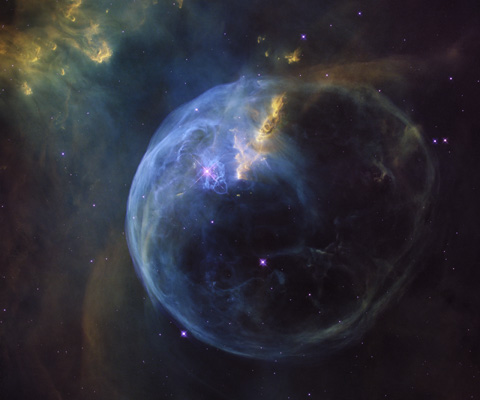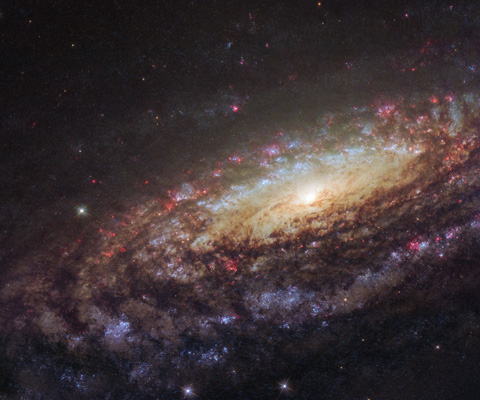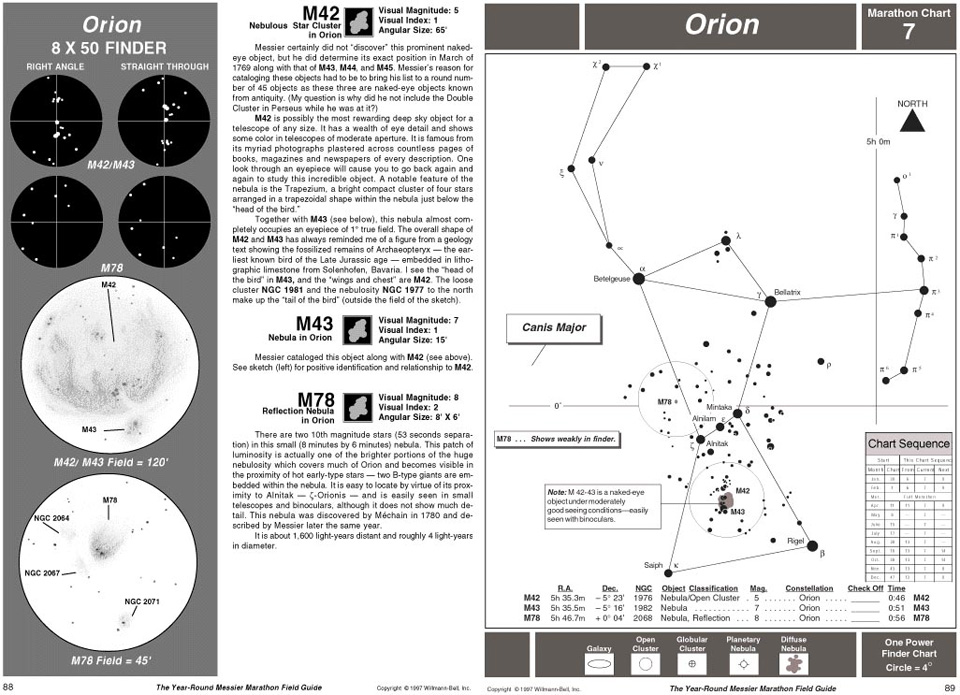Introduction
By no means complete, September’s mini guide that follows provides notes for exploring various interesting deep sky objects (DSOs) and lists other items of interest useful to the amateur astronomer.
Entries can be interpreted based on designation, description and magnitude as follows.
Designation – Description – Magnitude:
★ Telescopes 10-inch aperture minimum.
★★ Telescopes 6-inch to 9-inch aperture.
★★★ Binoculars (50mm+ aperture) and telescopes
3-inch to 5-inch aperture.
A collimated instrument, favourable atmospheric conditions, dark skies and dark-adapted eyes are assumed.

The Bubble Nebula (NGC 7635).
Credit: NASA/ESA Hubble space telescope.
About NGC 7635
The Bubble Nebula, also known as NGC 7635, is an emission nebula located 8,000 light-years away. This stunning image was observed by the NASA/ESA Hubble Space Telescope to celebrate its 26th year in space.
Credit: NASA, ESA, Hubble Heritage Team
Observation guide
| September deep sky objects |
| Andromeda constellation |
|
NGC 2392
|
One of the best planetary nebulae situated between Andromeda and Lacerta. Approximately 30" across and around 1,800 light years away can be seen in in smaller instruments and will show detail in instruments over 6 inches in aperture starting at 100x magnification.
|
9.0
|
★★★
|
| Cepheus constellation |
|
NGC 7160
|
Open cluster with little central concentration.
|
6.6
|
★★
|
|
NGC 7331
|
Planetary nebula in Cepheus. The nebula measures 40"x20" and will be seen in an 8-inch instrument in good conditions. Larger instruments will reveal structure in the nebula and at higher magnifications its central 12th magnitude star will also be visible.
|
10.7
|
★★
|
| Pegasus constellation |
|
NGC 7320
|
Spiral galaxy and the brightest member of the Stephan’s Quintet.
|
16.8
|
★★★
|
|
NGC 7331
|
Unbarred spiral galaxy in Pegasus close to eta Pegasi, requires an 8-inch instrument and dark skies. Larger instruments will show additional detail making it an interesting target.
|
9.7
|
★★
|
| Cassiopeia constellation |
|
NGC 7510
|
A young open cluster around 10 million years old.
|
7.9
|
★★
|
|
NGC 559
|
Open star cluster with stars 11th magnitude or fainter. Appears as a glow with false nebulosity in smaller scopes.
|
9.5
|
★★
|
|
NGC 129
|
Open Cluster of around 30 stars. Becomes visible in large binoculars and small scopes. Large scopes will show extra detail.
|
6.5
|
★★
|
|
NGC 7635
|
Diffuse nebula also known as the Bubble Nebula. It measures 3’ across and requires a minimum aperture of 12 inches and dark skies. It will reveal detail on CCD where it will appear as a semi-transparent sphere with faint tendrils.
|
11.0
|
★
|
|
M52
|
Open star cluster with hundreds of stars that can be seen in binoculars.
|
5.0
|
★★★
|
|
|
Designation, Description, Magnitude
|
★ Telescopes 10-inch aperture minimum.
★★ Telescopes 6-inch to 9-inch aperture.
★★★ Binoculars (50mm+ aperture) and telescopes 3-inch to 5-inch aperture.
|
The night sky
Under excellent conditions over 2,000 stars can be seen with the unaided eye but only a few hundred of these are prominent enough to be useful in navigating the night sky, these are normally included in amateur sky maps and digital planetarium programs like the SkySafari, Stellarium, The Sky, Starry Night, Winstars 2 etc. Some stars will show colour that is useful in identifying them. For example, Antares, Betelgeuse and Aldebaran are orange/red where Vega, Rigel and Spica appear as blue/white.
Stars that form easily recognisable patterns have been given names and are referred to as constellations. Of these, the brightest stars act as beacons and can be used to effectively navigate the night sky during the different months of the year. To that extent stars can be particularly useful in locating other interesting objects nearby normally viewable through binoculars or larger instruments.
Planets and their satellites, comets and meteors move independent of the night sky background and at comparatively high speeds. They are therefore very difficult or impossible to reference to any star. However, planets like Jupiter, Saturn, Venus and Mars as well as the Moon are easy to spot with the unaided eye and in the case of the larger planets and especially the Moon, even medium size binoculars will reveal a limited degree of detail.
About NGC 7331
This NASA/ESA Hubble Space Telescope image shows a spiral galaxy known as NGC 7331. First spotted by the prolific galaxy hunter William Herschel in 1784, NGC 7331 is located about 45 million light-years away in the constellation of Pegasus (The Winged Horse). Facing us partially edge-on, the galaxy showcases it’s beautiful arms which swirl like a whirlpool around its bright central region.
Astronomers took this image using Hubble’s Wide Field Camera 3 (WFC3), as they were observing an extraordinary exploding star — a supernova — which can still be faintly seen as a tiny red dot near the galaxy’s central yellow core. Named SN2014C, it rapidly evolved from a supernova containing very little Hydrogen to one that is Hydrogen-rich — in just one year. This rarely observed metamorphosis was luminous at high energies and provides unique insight into the poorly understood final phases of massive stars.
NGC 7331 is similar in size, shape, and mass to the Milky Way. It also has a comparable star formation rate, hosts a similar number of stars, has a central supermassive black hole and comparable spiral arms. The primary difference between our galaxies is that NGC 7331 is an unbarred spiral galaxy — it lacks a “bar” of stars, gas and dust cutting through its nucleus, as we see in the Milky Way. Its central bulge also displays a quirky and unusual rotation pattern, spinning in the opposite direction to the galactic disc itself.
By studying similar galaxies we hold a scientific mirror up to our own, allowing us to build a better understanding of our galactic environment which we cannot always observe, and of galactic behaviour and evolution as a whole.

The NGC 7331 spiral galaxy.
Credit: ESA/Hubble & NASA/D. Milisavljevic (Purdue University).
Sky conditions
The prevailing sky conditions will have a significant effect on what you can see through any instrument and binoculars. As such if you live near a city the light pollution can make it difficult to locate and observe most DSOs. The Moon and a hazy sky will also have a negative effect.
For best results observe from a dark site and under clear transparent skies without the moon being present. Once your eyes have been accustomed to the dark conditions (this takes around 20-30 minutes) you should be able to enjoy the night sky at its best.
Filters
Filters will help to an extent and lager instruments will benefit more from them. Light pollution filters would help and photo-visual UHC (nebula filters) would be worth considering.
Printed aids
A huge number of printed aids exist in terms of deep sky maps and books. An excellent printed guide for people new in astronomy is The Year-Round Messier Marathon Field Guide published by Willmann Bell Inc.
In this large format hard-back book, the author, Harvard Pennington shows how to:
- Learn 17 bright finder stars and 17 prominent finder constellations so you will know where to look for all 110 Messier objects.
- Align a sighting device such as an 8x50 finder scope or the Telrad® so that you can point your instrument rapidly and with assurance toward all of the Messier objects.
- Calibrate your instrument so that you know exactly how much sky you see through your finder and through the eyepiece of your instrument.
- Find all of the Messier objects using the maps, drawings and descriptions in this book. You will know exactly where to point your instrument, and what the object should look like when you find it.

Extract from The Year-Round Messier Marathon Field Guide
published by Willmann Bell Inc.
Related topics:
night sky, deep sky object guide, September



